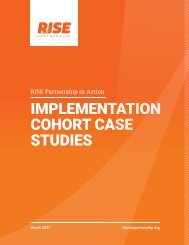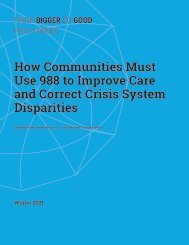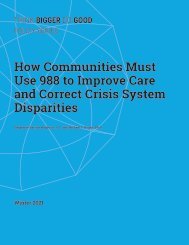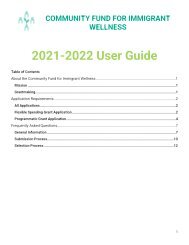Scattergood_IMD_Web
Create successful ePaper yourself
Turn your PDF publications into a flip-book with our unique Google optimized e-Paper software.
High readmission rates reflect the lack of appropriate care in<br />
EDs. In EDs, psychiatric patients are more likely to wait for<br />
extended periods (ranging from a single day to weeks) in beds,<br />
hallways, and locked rooms until inpatient beds become<br />
available—a practice euphemistically referred to as “boarding”<br />
(11). For psychiatric patients in particular, stress-inducing and<br />
restrictive EDs can cause deterioration, and an ACEP survey<br />
found that 62% of EDs provided no psychiatric services to<br />
patients who were boarded (7).<br />
Although there are no systemic data on the prevalence of<br />
boarding, recent studies suggest a widespread and growing<br />
problem that causes disruption in care. ACEP found that 80%<br />
of ED medical directors reported boarding psychiatric patients,<br />
and 90% of medical directors boarded psychiatric patients at<br />
least once per week, and over half boarded patients on a daily<br />
basis (7). The U.S. Department of Health and Human Services,<br />
ACEP, and the Joint Commission have all expressed concern<br />
over the prevalence and effect of psychiatric boarding and<br />
have identified insufficient inpatient bed supply as a common<br />
cause of the practice (12–14). Addressing boarding, scatter<br />
beds, and other disjunctions in the mental health care system<br />
will require significant shifts in care delivery, and the <strong>IMD</strong><br />
rule’s curtailment of financing options for inpatient care is one<br />
of several barriers to essential reform.

















